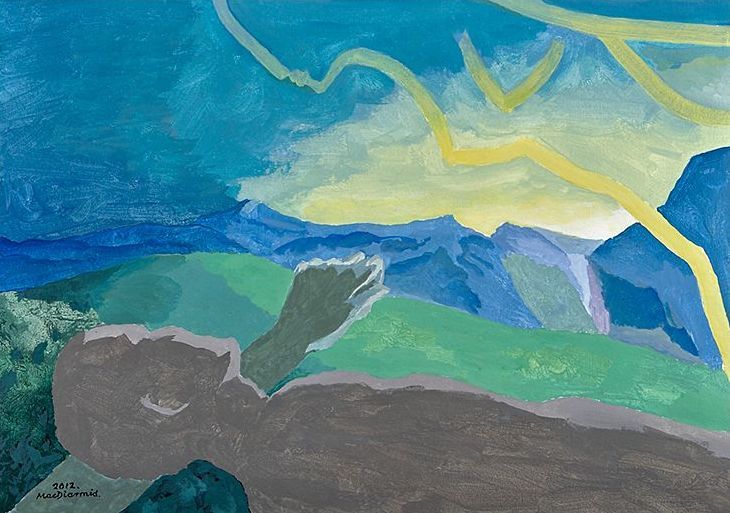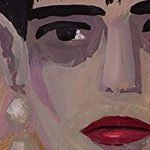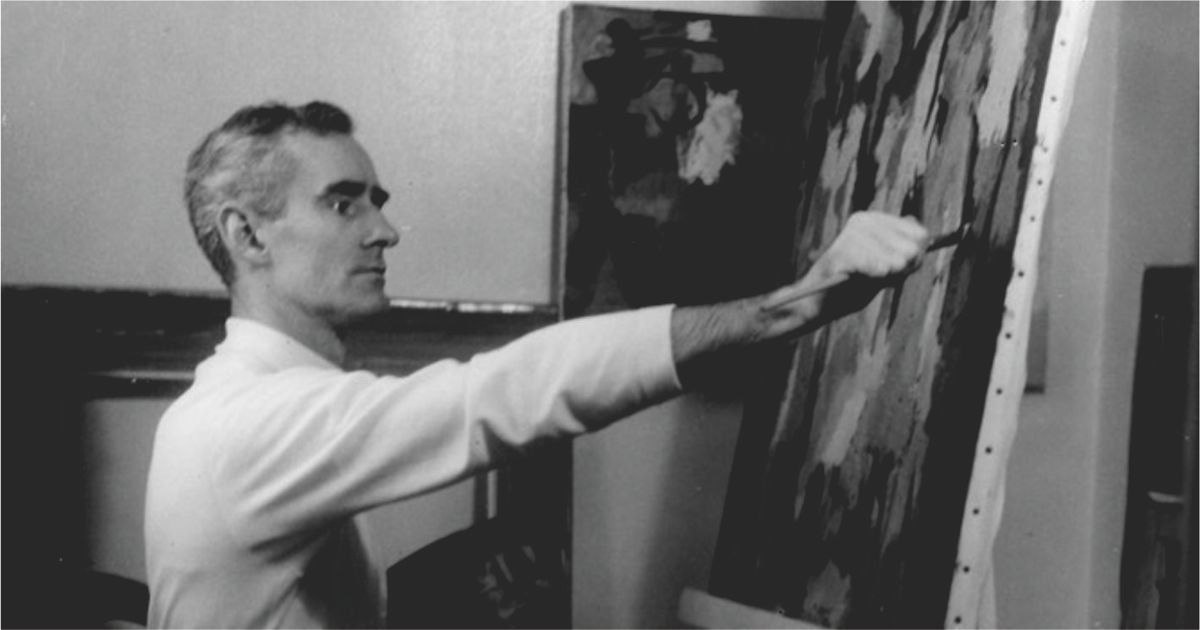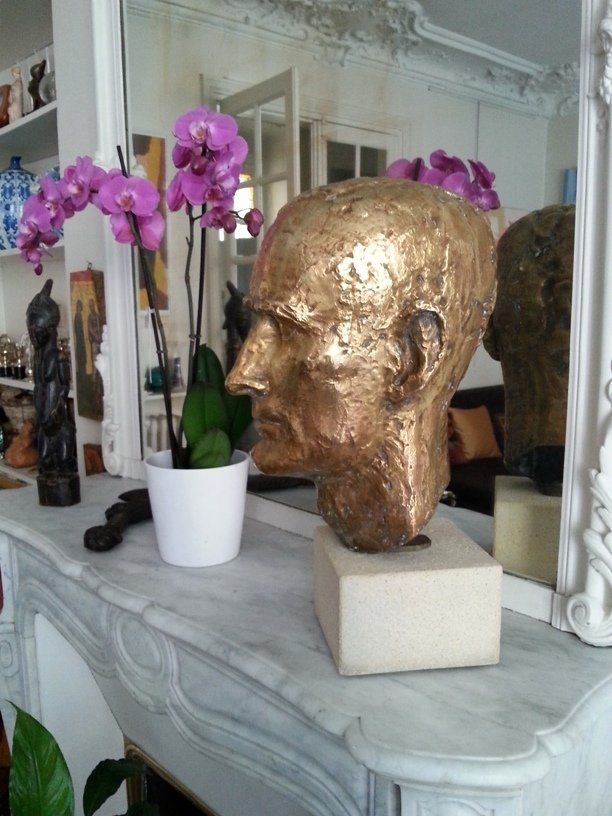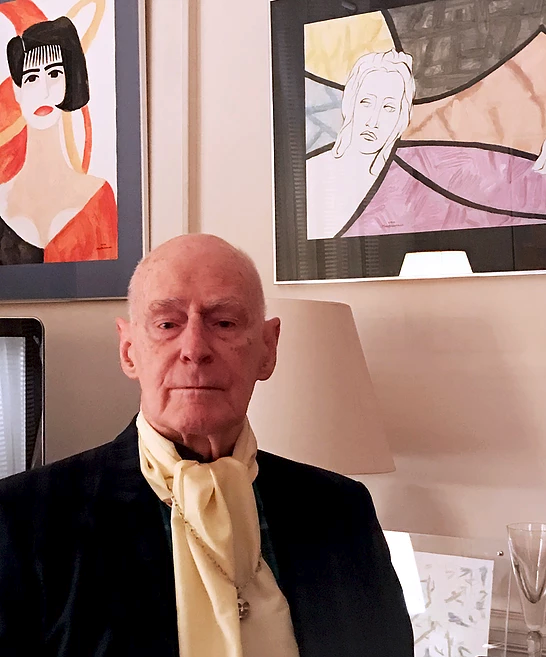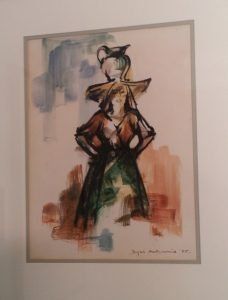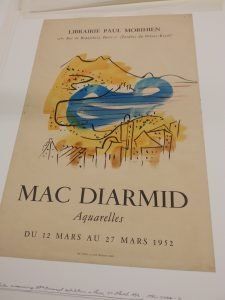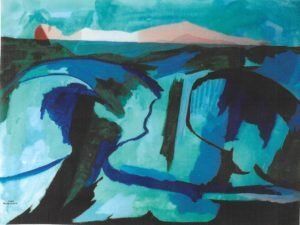Allegory New Zealand 1945
A surreal landscape given to close friends, émigré photographer Frank Hofmann and his poet wife Helen Shaw, before Douglas MacDiarmid left New Zealand in 1946. It has remained in the family ever since. Allegory says a lot about his state of being at the time. The war had ended in the South Pacific, there was hope for a brighter, safer future…but Douglas had no clarity of purpose beyond a burning desire to escape. Here a young couple are poised at the edge of a New Zealand landscape, looking down into a rich, green future of unknown tree forms. Or is it as simple as that….after all, an ‘allegory’ traditionally has a hidden meaning, political, moral or even personal, and Douglas was very particular in his use of language. Perhaps the underworld is a tangled abyss of seething disquiet threatening to burst through? Is this the first representation of him as the perennial ‘stranger everywhere’? Open doors continued to appear now and then in work throughout his career as a symbolic portal to another reality. This was the largest painting he had produced to that point, one he had poured more concentrated care and feeling into than anything else he had created. Certainly, the painting has attracted speculation and commentary through the years. It was no doubt considered quite startling when it appeared in Douglas’ first showing at The Group’s 1945 exhibition at Christchurch soon after being painted.
New Zealand’s most senior art historian Associate Professor Leonard Bell takes up the case in his Foreword to Douglas’ biography Colours of a Life: The life and Times of Douglas MacDiarmid… “On the edge, their backs to an open door, an architectural fragment, a man and a woman, small figures, look down into a chasm (or is it a reflection?) with entangled, fractured tree-like forms, as if the world were turned upside down,” he wrote. “Does this suggest the remains of war-battered Europe? Fields lying beyond with distant mountains echo verdant New Zealand, the Canterbury Plains and the Southern Alps perhaps. Striations of blues and greens mark the sky above. The painting’s various strata seem to come from different zones of time and place. Conventional unities are displaced. How could such a painting have been imagined in New Zealand in 1945? Allegory is anomalous. It doesn’t fit into the standard picture of New Zealand art then, and it doesn’t fit still. The picture is an early instance of the complexities, ambiguities and pluralities that characterise much of Douglas; art to come in Europe. His art, like the artist himself, looks in several directions in differing ways. It asks questions, it thinks, it doesn’t offer easy answers. Allegory is one of the strangest paintings produced in New Zealand. Estrangement and familiarity coexist.”
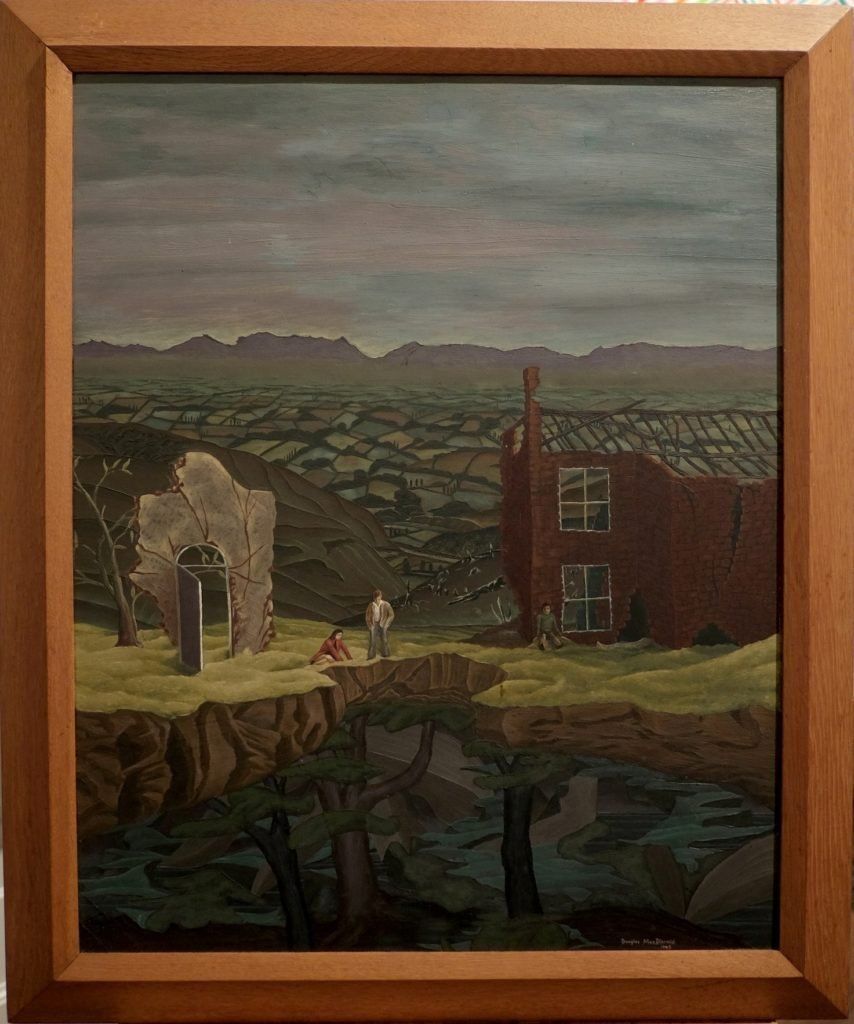
When Douglas received a colour photograph of the painting from the Hofmann family in 1995, he wrote back suggesting Frank and Helen, with their different aspirations and outlooks, are perhaps the figures in the painting and he (the crumbled figure against the building)… “Naturally I was delighted to see this picture reappear in this way, and the interest you show, of course irresistible. The couple idealised at the centre of their known world, inspired by true vision, are consequently fearlessly searching for clues to the future in the embryonic forms below their very feet, whereas the chap huddled against the dim ruins of remote influence is clearly a backward number, as neurotic as he is effete. The three figures are (God spare me) perfectly recognisable if one knows who to look for from so far back, and I can only add further blessings on your dear parents for getting you born too late even to begin to wonder with that particular precision. Needless to say, I can’t be expected to be helpful in this. Then of course you were right in supposing that the painting was composed from more than one source. In the main, Canterbury Plains from the Port Hills – in the clarity typical of Nor-westerly conditions. There is an echo of the tree cemeteries of the Taihape district thrown in, and the architectural bits smack of Europe and the imagination. At the time I painted it, it was the biggest piece I’d attempted, and meant more to me than anything else because of the chance to try to express preoccupations of the period – which since then have taken on a tincture of gross, typically youthful over-simplification. We can’t (and mustn’t) escape the past any more than we can piss away our genes, no matter how strong the desire for brave new worlds. (My determination to force local roots was in all likelihood the more fevered for the need to blind myself to my desperation to GET AWAY.) You’ll by now have gathered that your picture is more allegoric than surrealist… And I can think of no one to whom I’d rather have (at first) lent it than your parents. With time and the increase of mutual affection, questions of ownership disappeared as a matter of course. A painting belongs where it’s loved, and you have given me enormous pleasure in letting me know this picture is alive and well with you. Truly I am grateful also for the colour photo – in 1945 this was still science fiction – can you believe it!”
He told another friend in 2005, “Basically it was trying to say that if New Zealand were to become a museum copy of things European, we were doomed. We were all foaming with profundity at the time, as you well know, but if that can be kept in (or out) of perspective, I am far from disowning it as a painting. Further keys may never be forth-coming but it interests me now to observe the impact the Canterbury Plains exercised on me.” Tantalisingly, Douglas is leaving the door open, as it were, for our own sense of the scene.
That colour photograph of Allegory sits on the work table in MacDiarmid’s studio to this day. The painting is also reproduced in Chapters 1 and 3 of Colours of a Life, and made a brief, enigmatic appearance in the one-night exhibition at the James Wallace Trust’s The Pah Homestead in Hillsborough on 18 July 2018 for the Auckland launch of Douglas’ biography.
A few days after Douglas’ death on 26 August 2020, Stephen Hofmann wrote: “What a life. What a wonderful contribution to share and leave for the future generations to enjoy. Hella and Frank Hofmann were very good friends with Douglas, hence I am the proud owner of a wonderful painting Allegory New Zealand 1945. The painting depicts a young couple poised at the edge of a Canterbury landscape looking down into a rich, green future of unknown tree forms. Little did Douglas know that in another 70 years, Christchurch would once again start over again. Thank you Douglas, we will remember you fondly” – Stephen Hofmann.
To read more about Douglas MacDiarmid’s fascinating journey through life Buy your copy of Colours of a Life – the life and times of Douglas MacDiarmid by Anna Cahill (2018)

